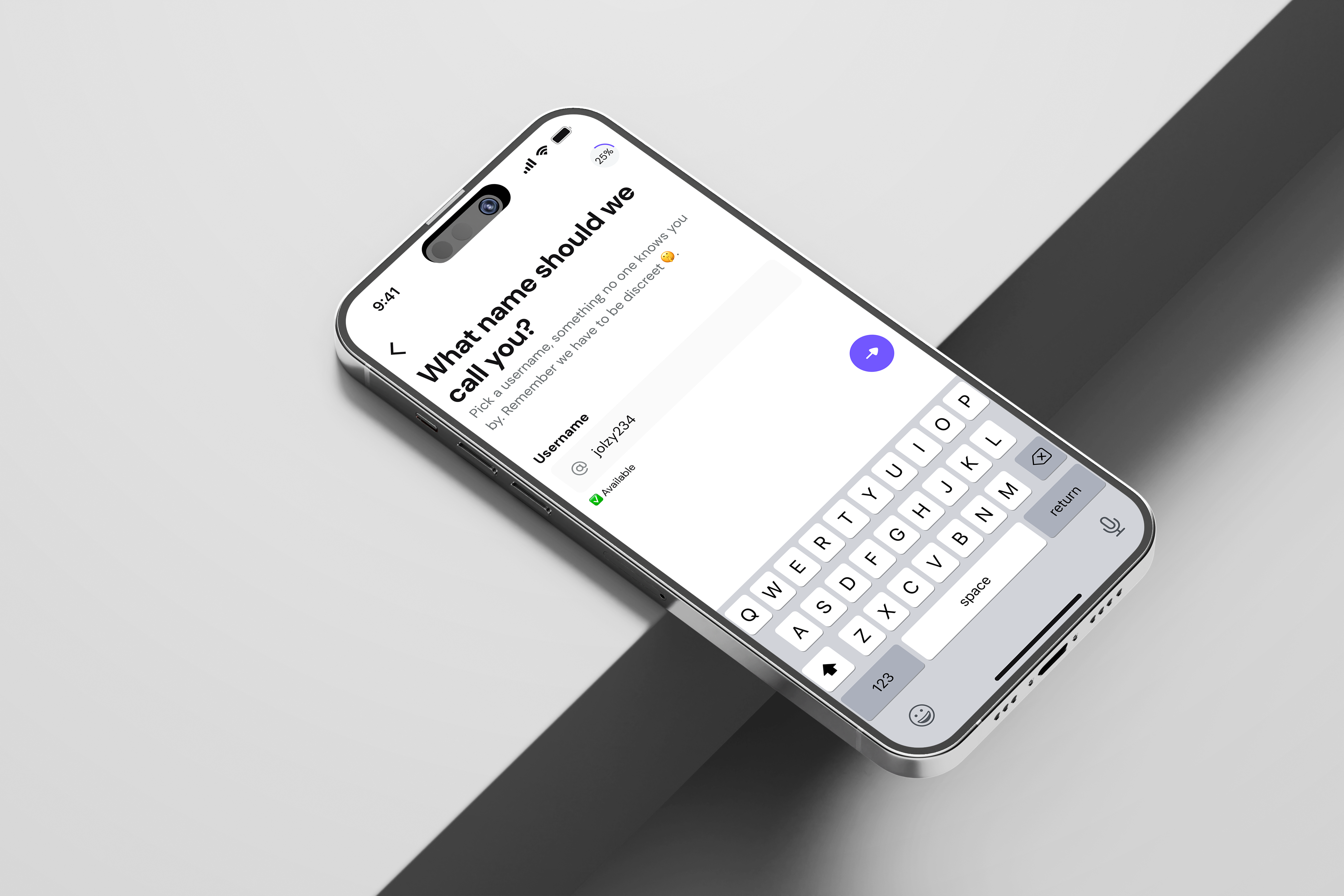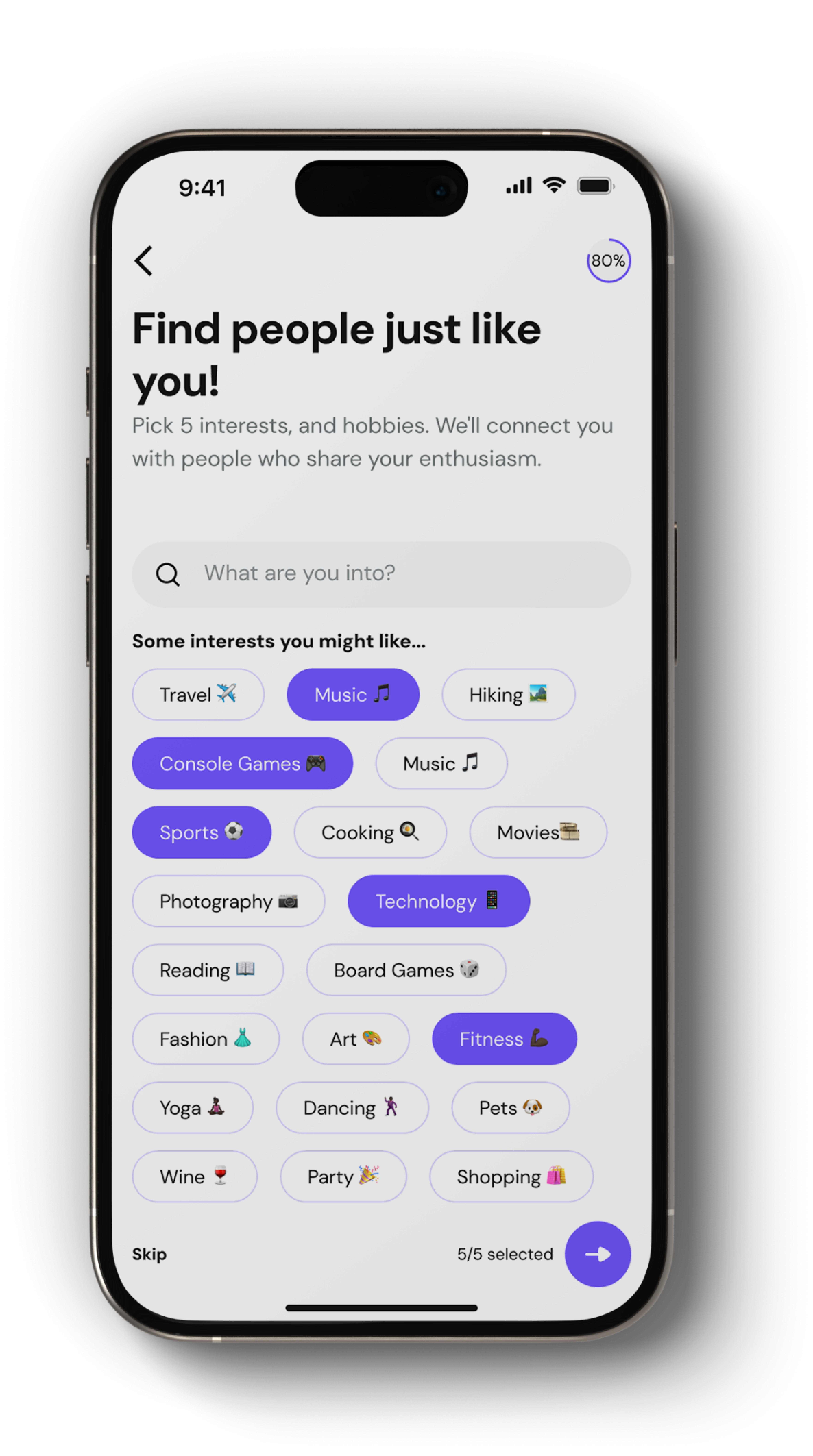Product Design
Pairr
Dating App

To design a discreet dating app for individuals seeking extramarital connections, ensuring privacy, inclusivity, and user engagement while navigating the ethical complexities of the subject matter.
In a digital landscape where privacy concerns and ethical considerations are paramount, the challenge was to create an app that facilitates extramarital connections while ensuring users' anonymity, security, and discretion. The app needed to balance the sensitive nature of its purpose with a seamless, inclusive, and engaging user experience.
In response to the unique challenge of creating a discreet dating platform for extramarital connections, I designed Pairr, a mobile app that prioritizes user privacy, inclusivity, and a seamless user experience. Pairr offers a safe, secure, and anonymous environment where users can explore their desires without fear of exposure. By integrating sophisticated privacy controls, a conversational onboarding process, and intelligent matchmaking algorithms, Pairr empowers users to connect discreetly and confidently. The app's design reflects a deep understanding of user needs and ethical considerations, ensuring a respectful and secure platform for all.
a. User Interviews & Surveys:
I conducted extensive user research to understand the motivations, fears, and expectations of potential users. The research was focused on individuals who were either currently using or had expressed interest in discreet dating apps. Key findings included:
Privacy as a Priority: The overwhelming majority of users emphasized the need for strong privacy controls. Fear of exposure was the biggest deterrent to using such platforms.
Simple and Quick Interactions: Users expressed a desire for an app that allowed for swift interactions without unnecessary complexities. They wanted to connect with potential matches quickly and discreetly.
Inclusivity: There was a strong demand for an app that acknowledged and catered to a diverse range of genders, sexual preferences, and relationship statuses.
b. User Personas:
Based on the research, we developed detailed personas that guided the design process. Here are a few examples:

Age: 35
Occupation: Freelance Writer
Location: Abuja, Nigeria
Relationship Status: Married (Attached Female seeking Males)
Income Level: ₦8,000,000 annually
Tech Savviness: Moderate
Hobbies & Interests: Reading, Yoga, Painting, Social Media
Personality: Curious, Artistic, Empathetic, Discreet
Goals:
To find a discreet partner who can provide emotional and physical intimacy without threatening her marriage.
To engage in conversations and relationships that are emotionally fulfilling yet secretive.
To use a platform that feels safe, intuitive, and tailored to her needs.
Pain Points:
Emotional Disconnect: Cynthia feels emotionally disconnected from her spouse and is seeking fulfillment elsewhere.
Fear of Judgment: She fears being judged if her extramarital activities are ever discovered.
Ease of Use: Cynthia wants a platform that is easy to navigate and doesn't require too much technical know-how.
Behavior:
Prefers apps with user-friendly interfaces that don't overwhelm her with options.
Values emotional connections and prefers to spend time getting to know her matches before meeting.
Engages more with content that resonates emotionally, like personal stories or relatable prompts.
Motivations:
Emotional Fulfillment: Cynthia is looking for a connection that fills the emotional gaps in her marriage.
Discretion: She needs a platform that ensures her activities remain private and that her identity is protected.
Inclusivity: She wants a space where she feels understood and catered to, particularly as a woman in her situation.
Design Considerations:
Conversational UI: Implement soft, empathetic language throughout the app, especially during the onboarding process.
Privacy & Security: Highlight features that protect her identity, like blurred photos, pseudonyms, and customizable profile visibility.
Emotional Engagement: Create sections that allow for more in-depth personal information sharing, like hobbies and interests.

Age: 33
Occupation: Senior Executive at a Tech Company
Location: Lagos, Nigeria
Relationship Status: Married (Attached Male seeking Females)
Income Level: ₦20,000,000 annually
Tech Savviness: High
Hobbies & Interests: Golf, Traveling, Fine Dining, Technology
Personality: Discreet, Confident, Strategic, High-achiever
Goals:
To find discreet, no-strings-attached connections with women who understand his need for privacy.
To maintain absolute secrecy about his extramarital activities, both online and offline.
To connect with like-minded individuals who share similar interests and understand his lifestyle.
Pain Points:
Fear of Exposure: Olufemi’s high-profile job and social standing make him extremely cautious about his extramarital activities.
Time Constraints: His busy schedule means he needs an app that allows him to connect quickly and efficiently.
Privacy Concerns: Olufemi is concerned about leaving a digital footprint that could be traced back to him.
Behavior:
Uses incognito mode on his browser and prefers apps with strong privacy controls.
Prefers minimal communication; likes to get to the point quickly.
Selects premium services that promise added security and discretion.
Motivations:
Desire for Excitement: Despite being married, Olufemi is looking for something that brings excitement back into his life.
Control: He wants to be in control of his encounters, both in terms of privacy and the nature of his relationships.
Discretion: Olufemi seeks absolute discretion to avoid any risk of exposure.
Design Considerations:
Quick Access Features: Design for easy access to matches and messaging with minimal navigation required.
Strong Privacy Controls: Emphasize features that allow Olufemi to control who sees his profile, blur his photos, and manage notifications.
Premium Features: Highlight the benefits of subscribing to premium services for enhanced security.

Ashley Madison is one of the most well-known platforms for extramarital affairs, with a global user base and a strong emphasis on discretion and privacy. The site’s tagline, “Life is short. Have an affair,” is bold and directly appeals to its target audience.
Strengths:
Brand Recognition: Ashley Madison is a well-established name in the market, which lends credibility and attracts users.
Privacy Controls: Features like the “Panic Button,” which quickly redirects users to a neutral website, and the ability to blur profile photos are highly valued by users.
Global Reach: The platform has a vast user base across many countries, making it easier for users to find matches.
Weaknesses:
Security Breach History: Ashley Madison suffered a major data breach in 2015, which exposed the personal information of millions of users. This has led to trust issues with potential new users.
Limited Inclusivity: While the platform offers options for various relationship statuses, it is less inclusive of diverse gender identities and sexual preferences.
Overly Bold Branding: The direct and unapologetic branding may deter some users who are looking for a more subtle approach to discreet dating.
Opportunities for Pairr:
Enhanced Privacy: Pairr can differentiate itself by offering even more robust privacy features, such as customizable profile visibility and encrypted communications.
Inclusivity: By catering to a broader range of gender identities and sexual preferences, Pairr can attract users who feel underrepresented by competitors.
Subtle Branding: A more understated and sophisticated branding approach could appeal to users who find Ashley Madison’s messaging too overt.

Gleeden is a dating platform targeted primarily at women seeking extramarital affairs. It positions itself as a women-first platform, emphasizing safety and discretion. The platform is especially popular in Europe.
Strengths:
Women-Centric: Gleeden’s focus on women’s experiences makes it appealing to female users who want to feel safe and empowered in their interactions.
Strong Privacy Features: The platform offers features like “Stealth Mode,” allowing users to browse profiles without being seen, and discreet notifications.
Community Feel: Gleeden fosters a community-driven experience with forums and discussion groups where users can share their experiences.
Weaknesses:
Niche Audience: The platform’s strong focus on women may limit its appeal to a broader audience, particularly men or nonbinary individuals.
Limited Global Reach: Gleeden is primarily popular in Europe, which might limit its appeal to users in other regions.
Traditional User Interface: The UI/UX design of Gleeden is somewhat dated, and the app lacks the modern, intuitive feel that younger users might prefer.
Opportunities for Pairr:
Broader Inclusivity: Pairr can attract a wider audience by offering a more inclusive platform that caters to all genders and sexual preferences.
Modern Design: By focusing on a sleek, modern, and user-friendly design, Pairr can appeal to tech-savvy users who value aesthetics and usability.
Global Reach: Expanding the platform’s reach to include a global audience could position Pairr as a more accessible option for users worldwide.
The ethical implications of designing an app for extramarital affairs were carefully considered. My experience in NDPR and GDPR helped me ensure that the app complied with data protection regulations (e.g., GDPR). Additionally, I held internal discussions with stakeholders to create a balance between user needs and ethical responsibility, ensuring that the app did not encourage harmful behavior but rather provided a safe space for those already seeking such connections.
1. Information Architecture:
The information architecture was meticulously designed to create a seamless and intuitive user experience while prioritizing privacy and discretion. Key components included:
Onboarding Process:
Designed as a conversational journey to build trust from the start. Users are gently guided through creating their profiles with prompts like “Let’s get to know you a little better.”
The process was segmented into bite-sized steps, each with reassuring language to reduce user anxiety.
User Profiles:
Profiles were designed to be minimalistic, allowing users to display only the information they were comfortable sharing. Options to blur profile pictures and use pseudonyms were emphasized.
A feature was added to allow users to control who could view their profiles, enhancing privacy.
Matchmaking Algorithm:
The algorithm prioritized discretion, allowing users to match based on shared interests, location, and activity levels while protecting their identity.
An opt-in feature for enhanced matchmaking based on user behaviors and preferences was included to ensure relevance.
Communication Tools:
Messaging features included end-to-end encryption, self-destructing messages, and notifications that could be customized to ensure discretion.
Users could send blurred images, with the recipient having the option to reveal them, ensuring control over sensitive content.
Payment & Subscription:
Payment systems were designed to be discreet, with nondescript billing descriptions and options for purchasing credits or upgrading to premium services.
The upgrade prompts were strategically placed and designed to be subtle, offering value rather than pushing sales.
The visual design was crafted to reflect the app’s discreet nature while appealing to a sophisticated audience. The color palette was carefully chosen to convey secrecy and elegance. The typography was chosen for its modern yet discreet appearance, with a focus on readability and elegance. Shadows and gradients were used to add depth to the design, subtly guiding users’ attention to key features without overwhelming them.
Interactive Prototypes:
Interactive prototypes were created using Figma, allowing testers to simulate the app’s core functionalities. These prototypes included the full user journey, from onboarding and profile creation to browsing matches and secure messaging. Key interactions, such as blurring/unblurring photos and using privacy features, were tested extensively.
Usability Testing:
a. Testing Sessions:
I conducted usability testing with a diverse group of users who matched our personas. The sessions were both remote and in-person, and they provided valuable insights into how users interacted with the app.
b. Key Findings:
Onboarding Experience:
Users found the conversational onboarding process to be engaging and reassuring. The step-by-step approach helped reduce anxiety, and the language used made the experience feel personal.
Some users suggested even more granular privacy controls during onboarding, such as the ability to choose who could see specific profile elements.
Privacy Features:
The ability to blur photos and control who could view the profile was highly appreciated. Users felt that these features gave them a sense of security and control.
The notification management options were seen as a major advantage, especially the ability to hide app-related notifications.
Matchmaking Process:
Users liked the interest-based filters but suggested adding more specific options to better refine matches.
3. Iterations:
Based on the usability testing, several iterations were made:
Enhanced Privacy Controls:
Additional privacy settings were introduced, allowing users to customize the visibility of individual profile elements.
The onboarding process was updated to include more detailed explanations of privacy features, ensuring users understood their options from the start.
Improved Match Filtering:
More interest-based filters were added, along with suggestions based on user activity, to improve the relevance of matches.
Streamlined Navigation:
The user interface was further simplified, reducing the number of steps required to perform key actions such as messaging or purchasing credits.
Navigation between different sections of the app was made more intuitive, with clear labels and subtle visual cues.

Decision:
To create a welcoming and engaging first impression, the onboarding process was designed to be conversational and user-centered. This approach helps ease users into the app, making them feel comfortable and understood from the moment they sign up.
Implementation:
Conversational Prompts: Instead of traditional form fields, the onboarding process uses friendly, humanized prompts like "Let's get you started with your name" or "What are you looking for on Pairr?"
Personalized Experience: The onboarding questions are tailored to gather key information without overwhelming the user, ensuring a smooth and personalized setup process.
Rationale:
This conversational approach humanizes the onboarding experience, making it feel more like a guided interaction rather than a series of transactional steps. It helps build rapport with users and encourages them to complete the setup process.

Decision:
From the outset, it was clear that privacy and discretion would be the foundation of Pairr's design. Given the sensitive nature of extramarital relationships, users need absolute assurance that their personal information and activities remain confidential.
Implementation:
Anonymous Browsing: Users can browse profiles anonymously, preventing others from knowing who viewed their profiles unless they choose to reveal themselves.
Screenshot Blocking: The app automatically blocks screenshots to prevent users from saving or sharing sensitive content.
Self-destruct message: Users can send messages that automatically self-destruct after 24 hours.
Disappearing Pictures: Users can send photos that disappear after being viewed once.
Customizable Profile Visibility: Users have full control over who can view their profiles, with options to blur photos or use pseudonyms.
Discreet Notifications: All notifications and communications are kept discreet, with options for users to customize how and when they receive alerts.
Rationale:
These features are designed to build trust with users, ensuring they feel safe and confident while using the app. By prioritizing privacy, Pairr differentiates itself from competitors and addresses the primary concern of its target audience.

Decision:
Pairr's design balances aesthetics with functionality, ensuring that the app is visually appealing while remaining intuitive and easy to navigate. The color palette and visual elements were chosen to evoke feelings of elegance, discretion, and modernity.
Implementation:
Color Palette: A refined color scheme with muted, sophisticated tones was selected to reinforce the app’s focus on discretion and luxury.
Minimalistic Interface: The interface is kept clean and minimal, with clear navigation and a focus on key actions like browsing matches and messaging.
Modern Typography: DM Sans was chosen to enhance readability while conveying a sense of sophistication.
Rationale:
The aesthetic choices reflect the app’s target demographic—users who are likely professionals or individuals seeking a discreet, premium experience. By combining visual appeal with functional design, Pairr ensures that users can navigate the app effortlessly while enjoying a polished and modern interface.

Decision:
To create an inclusive platform, Pairr was designed to cater to a diverse range of gender identities, sexual preferences, and relationship statuses. This decision was based on the understanding that users come from various backgrounds and have different needs in terms of how they identify and the types of relationships they seek.
Implementation:
Diverse Gender Options: The app includes a comprehensive list of gender identities beyond the binary options, such as nonbinary, genderqueer, and genderfluid.
Wide Range of Sexual Preferences: Users can select from various sexual preferences, ensuring that everyone feels represented and respected.
Relationship Status Options: Pairr offers a variety of relationship statuses, from "Attached Male seeking Females" to "Single Female seeking Males," allowing users to accurately represent their situation.
Rationale:
Inclusivity is critical for fostering a welcoming environment where all users feel seen and valued. By offering these diverse options, Pairr not only attracts a broader audience but also ensures that the app aligns with modern values of equality and representation.

Decision:
To keep users engaged and encourage them to invest in the platform, gamification elements and premium features were incorporated into the design. This approach not only enhances the user experience but also provides additional revenue streams for the app.
Implementation:
Credit System: Users can earn or purchase credits to unlock special features, such as viewing matches, sending gifts, or boosting their profile visibility.
Pairr Premium: A premium subscription offers exclusive benefits like advanced privacy controls, priority customer support, and access to premium matches.
Rationale:
These gamification and premium features are designed to increase user engagement by providing incentives for continued use and encouraging users to upgrade for a more enhanced experience. They add value to the platform while keeping the user experience dynamic and interactive.


































Designing Pairr was a complex and challenging project that required a delicate balance of user engagement, privacy, and ethical considerations. The final product not only met the client’s requirements but also provided a secure, inclusive, and engaging platform for users seeking discreet connections. The success of the app highlights the importance of understanding user needs, prioritizing privacy, and continuously iterating on the design to deliver a superior user experience.